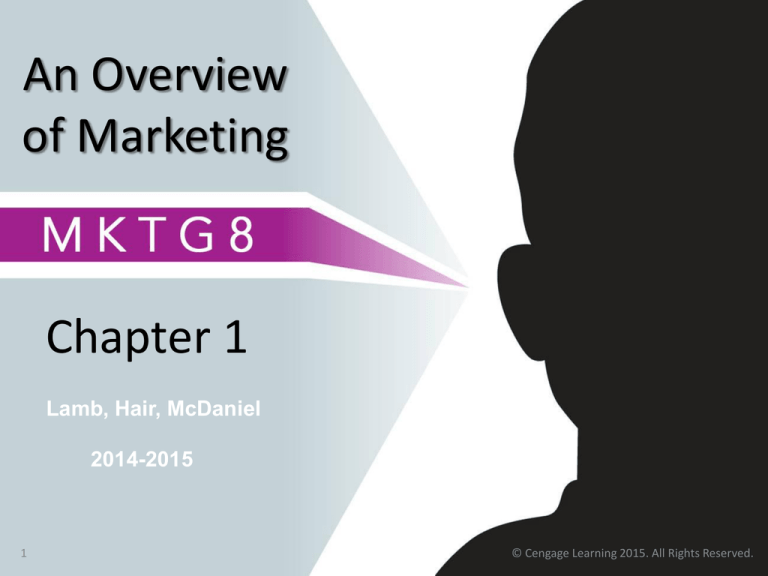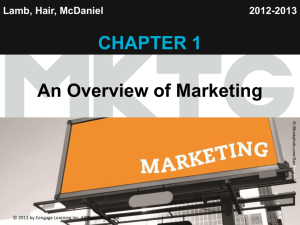
An Overview
of Marketing
Chapter 1
Lamb, Hair, McDaniel
2014-2015
1
© Cengage Learning 2015. All Rights Reserved.
1
Define the term marketing
2
Describe four marketing management
philosophies
3
Discuss the differences between sales and
market orientations
4
Describe several reasons for studying
marketing
© 2015 by Cengage Learning Inc. All Rights Reserved.
2
Marketing is…
1. A philosophy, an attitude, a
perspective, or a management
orientation that stresses customer
satisfaction.
2. An organizational activity, set of
institutions, and processes.
1
© 2015 by Cengage Learning Inc. All Rights Reserved.
3
American Marketing Association
Definition of Marketing
Marketing is the activity, set of
institutions, and processes for
creating, communicating, delivering,
and exchanging offerings that have
value for customers, clients, partners,
and society at large (Approved July
2103)
1
© 2015 by Cengage Learning Inc. All Rights Reserved.
4
The Marketing Environment
Product
Price
Promotion
Place
Exchange
At Least Two Parties
Something of Value
Conditions for
Exchange
Communication and Delivery
Freedom to Accept or Reject
1
Desire to Deal with Other
Party
© 2015 by Cengage Learning Inc. All Rights Reserved.
6
Exchange
• Exchange may not take place even
if conditions are met.
• An agreement must be reached.
• Marketing occurs even if exchange
does not take place.
1
© 2015 by Cengage Learning Inc. All Rights Reserved.
7
The Four Marketing Management
Philosophies
Orientation
Production
2
Focus is on…
internal capabilities of the firm
Sales
aggressive sales techniques and belief
that high sales result in high profits
Market
satisfying customer needs and wants
while meeting objectives
Societal
satisfying customer needs and
wants while enhancing individual and
societal well-being
© 2015 by Cengage Learning Inc. All Rights Reserved.
8
Questions That Help Determine Marketing
Philosophy
Orientation
2
Focus
Production
What can we make or do best?
Sales
How can we sell more aggressively?
Marketing
What do customers
want and need?
Societal
What do customers want/need, and
how can we benefit society?
9
© 2015 by Cengage Learning Inc. All Rights Reserved.
Market Orientation
Marketing Concept
Focusing on customer wants and needs to
distinguish products from competitors’ offerings
Integrating all the organization’s activities to
satisfy these wants
Achieving the organization’s long-term goals by
satisfying customer wants and needs legally and
responsibly
2
© 2015 by Cengage Learning Inc. All Rights Reserved.
10
Societal Marketing Orientation
An organization exists not only to
satisfy customer wants but also to
preserve or enhance individuals’ and
society’s long-term best interests.
For example:
• Less toxic products
• More durable products
• Products with reusable or recyclable
materials
2
© 2015 by Cengage Learning Inc. All Rights Reserved.
11
Differences between Sales
and Market Orientations
Sales Orientation
Inward looking
What the firm makes
Market Orientation
Outward looking
What the market wants
3
© 2015 by Cengage Learning Inc. All Rights Reserved.
12
Sales vs. Market Orientations
Organization’s Firm’s
Focus
Business
For
Whom?
Primary
Profit
Goal?
Sales
Orientation
Inward
Selling
goods
and
services
Everybody Maximum
sales
volume
Market
Orientation
Outward
Satisfying
wants
and
needs
Specific
groups
of
people
Customer
satisfaction
© 2015 by Cengage Learning Inc. All Rights Reserved.
Tools to
Achieve
Primarily
promotion
Coordinated use of
marketing
activities
13
Relationship Marketing
Strategy that focuses on keeping and
improving relationships with customers.
Successful strategies need:
–
–
–
–
Customer-Oriented Personnel
Effective Training Programs
Empowered Employees
Teamwork
3
© 2015 by Cengage Learning Inc. All Rights Reserved.
14
Offering “Customer Value”
3
Offer products that perform
Earn trust
Avoid unrealistic pricing
Give the buyer facts
Offer organization-wide
commitment in service and aftersales support
Co-creation with customers
© 2015 by Cengage Learning Inc. All Rights Reserved.
15
Customer Satisfaction
The customers’ evaluation of a
good or service in terms of
whether that good or service
has met their needs and
expectations.
3
© 2015 by Cengage Learning Inc. All Rights Reserved.
16
Building Relationships
Customer-oriented personnel
Every
employee represents the firm in the
eyes of the customer.
Employee training programs
Empowered employees
Employees are given more authority to
solve customer problems on the spot.
Teamwork
Emphasizing cooperation over
competition while helping a customer.
3
© 2015 by Cengage Learning Inc. All Rights Reserved.
17
Why Study Marketing?
Important
to Society
Important to
Business
Good Career
Opportunities
Marketing affects
you every day!
4
© 2015 by Cengage Learning Inc. All Rights Reserved.
18
Chapter 1 Video
Geoffrey B. Small
Geoffrey B. Small is a super luxury fashion
designer with an eye towards social justice and
connecting with his buyers. In this video, Small
discusses how he began designing clothes and
deciding who and how to connect with his
customers. He also discusses the nature of
consumer behavior and beliefs in terms of how
they purchase fashion and its effect on clothing
prices.
CLICK TO PLAY VIDEO
19
© 2015 by Cengage Learning Inc. All Rights Reserved.
Ch 1: Discussion Questions
1. Define marketing. Explain the marketing process
we discussed in the class.
2. Define exchange. What role does exchange play in
marketing?
3. Describe the four marketing management
philosophies. Explain how sales orientation differs
from marketing orientation.
4. Define relationship marketing and its implications
in business.
5. Why should we study marketing? How does it
affect our daily lives?




